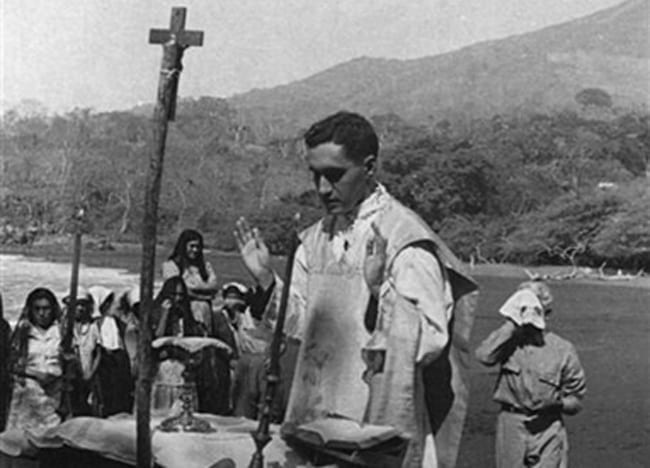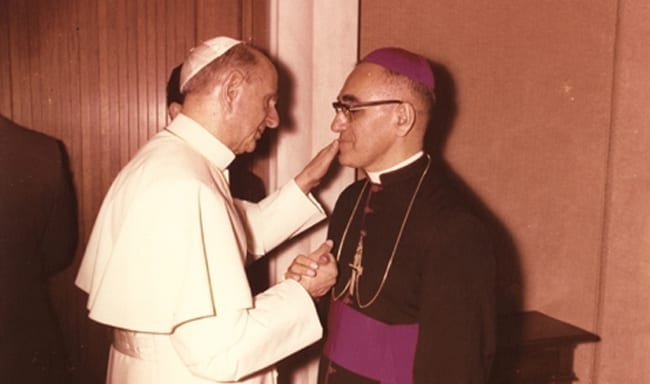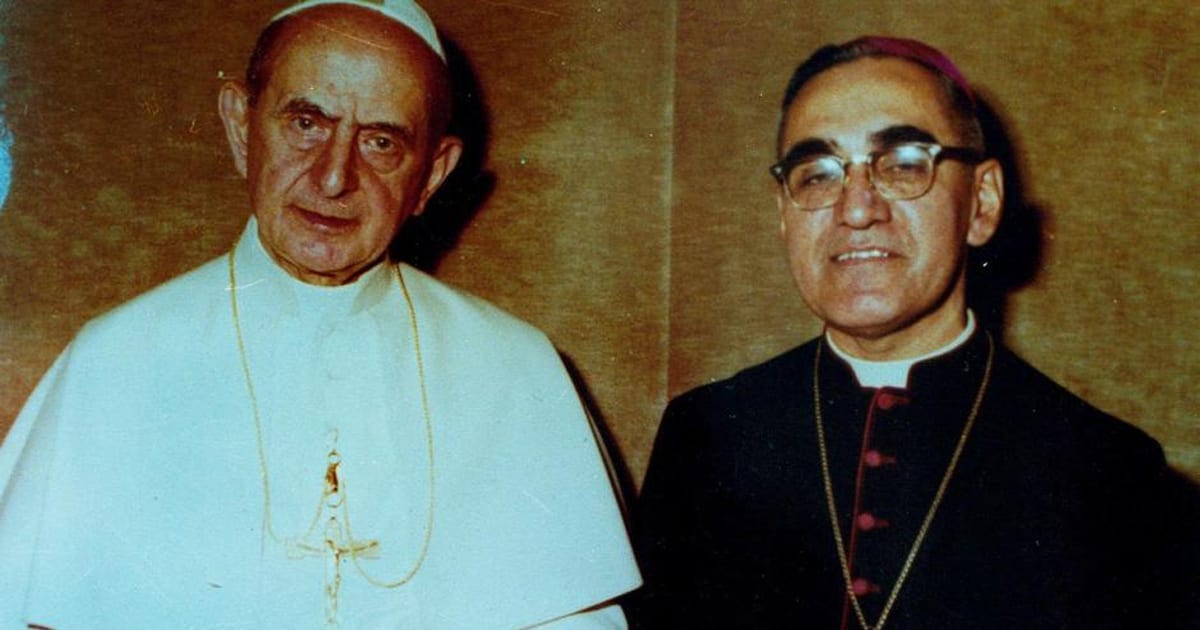
Pope Paul VI and Archbishop Oscar Romero in an undated photo.
Each of the new saints lived lives marked by pain and criticism — including from within the church — but all of them dedicated themselves with passionate love to following Jesus and caring for the weak and the poor, Pope Francis said in his homily.
An outspoken advocate for the poor, Archbishop Oscar Romero was shot and killed March 24, 1980, as he celebrated Mass at a hospital in San Salvador during the country’s civil war. He called for an end to the violence and killing of civilians during the war, which lasted from 1979 until 1992.
Pope Paul VI is best remembered for seeing the Second Vatican Council through to its end and helping implement its far-reaching reforms.

Pope Paul VI is seen in an undated official portrait. (CNS photo/Felici, Catholic Press Photo)
The other five new saints are: Vincenzo Romano, a diocesan priest known as the “the workers’ priest”; Nazaria Ignacia March Mesa, founder of the Congregation of the Missionary Crusaders of the Church; Catherine Kasper, founder of the religious congregation the Poor Handmaids of Jesus Christ; Francesco Spinelli, a diocesan priest and founder of Sisters Adorers of the Blessed Sacrament; and Nunzio Sulprizio, who as a young teen developed gangrene in his leg, faced tremendous pain with patience and serenity and offered up his sufferings to God before he passed away at age 19.
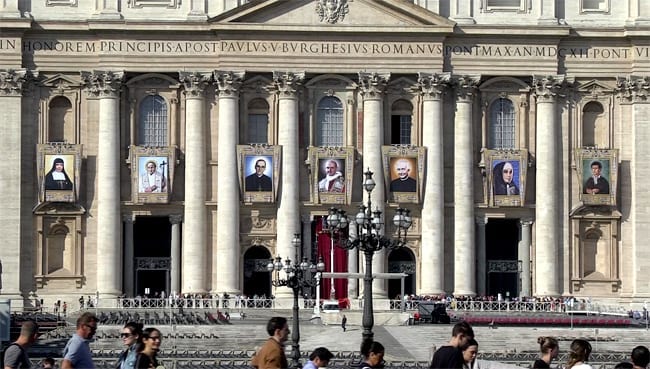
Banners of the seven new saints overlook St. Peter’s Square.
In his homily, Pope Francis said that “Jesus is radical.”
“He gives all and he asks all; he gives a love that is total and asks for an undivided heart,” the pope said. “Even today he gives himself to us as the living bread; can we give him crumbs in exchange?”
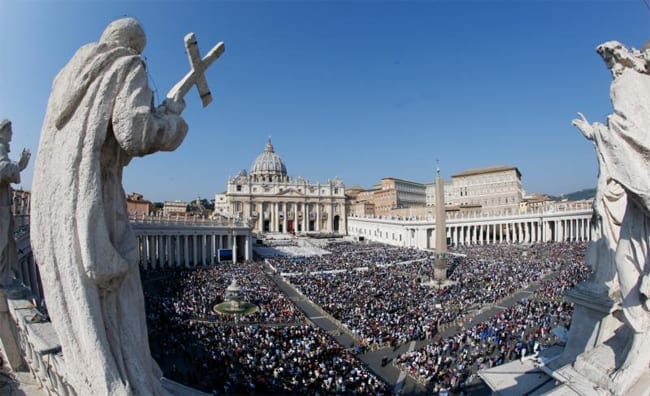
Pope Francis celebrates the canonization Mass for seven new saints in St. Peter’s Square at the Vatican Oct. 14. (CNS photo/Paul Haring)
Jesus, he said, “is not content with a ‘percentage of love.’ We cannot love him 20 or 50 or 60 percent. It is either all or nothing” because “our heart is like a magnet — it lets itself be attracted by love, but it can cling to one master only and it must choose: either it will love God or it will love the world’s treasure; either it will live for love or it will live for itself.”
Archbishop Oscar Romero
Born in Ciudad Barrios, El Salvador, on Aug. 15, 1917, Oscar Romero entered a minor seminary at the age of 13. During his years of priestly ministry, young Romero served the poor and the suffering of his country.
Romero became archbishop of San Salvador in 1977 and emerged as a champion for the poor and an uncompromising critic of a government he said legitimized terror and assassinations. His radio show and homilies drew thousands of listeners and earned him the title “Voice of the Voiceless.”
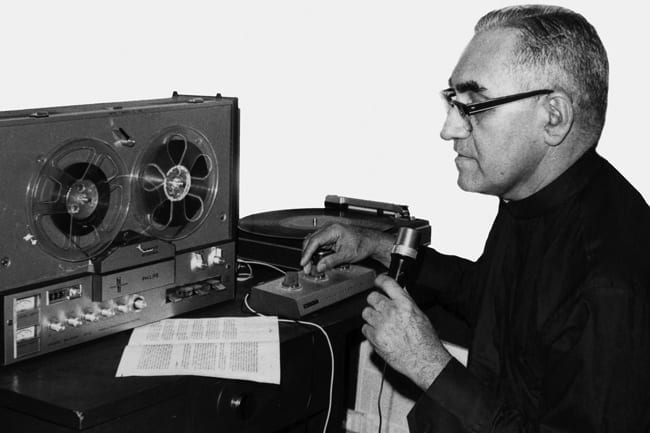
Archbishop Oscar Romero is seen in an undated photo working in an improvised radio studio in San Salvador. (CNS photo/Octavio Duran)
On March 23, 1980, in response to increasing violence, Archbishop Romero gave a homily in which he told soldiers to follow the law of God and disobey orders to fire on unarmed civilians.
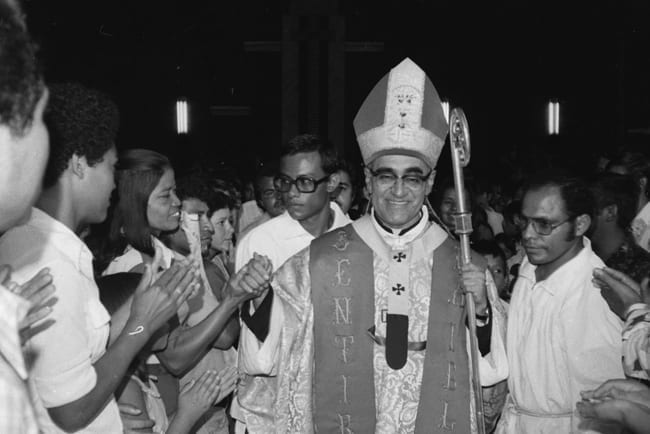
Archbishop Oscar Romero greeting worshippers in San Salvador, El Salvador. (CNS photo/Octavio Duran)
“In the name of this suffering people, whose cries rise to heaven each day more tumultuous, I beseech you, I beg you, I order you, in the name of God, stop the repression,” he said during the homily.
The next day, he was fatally shot by an assassin while celebrating Mass in the chapel of a hospital. The Catholic Church deemed that his violent death was carried out “in hatred of the faith,” and he was beatified May 23, 2015.
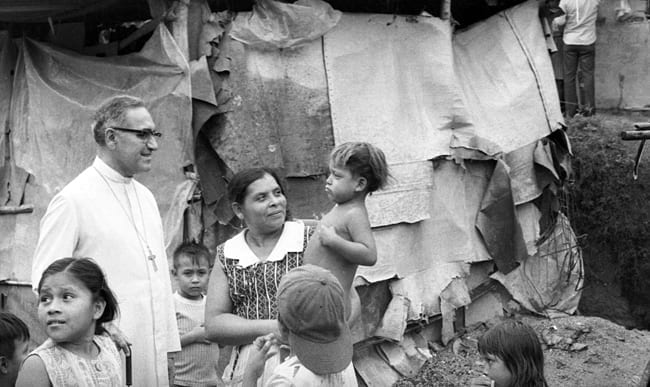
Archbishop Óscar Romero visits Ateos in San Salvador, El Salvador, in 1979. (NCR photo/June Carolyn Erlick)
Jesuit Father Tom Greene, superior of the Jesuit Community of Belize, said that Romero “had a heart for the poor because of what the poor had done for him.”
Salvadoran Mercy Sister Ana Maria Pineda, associate professor of religious studies at the Jesuits’ University of Santa Clara in California, said that her students see in Romero “the best of what they hope for in church leaders” and identify with his humanity as a person with both “gifts and limitations.”
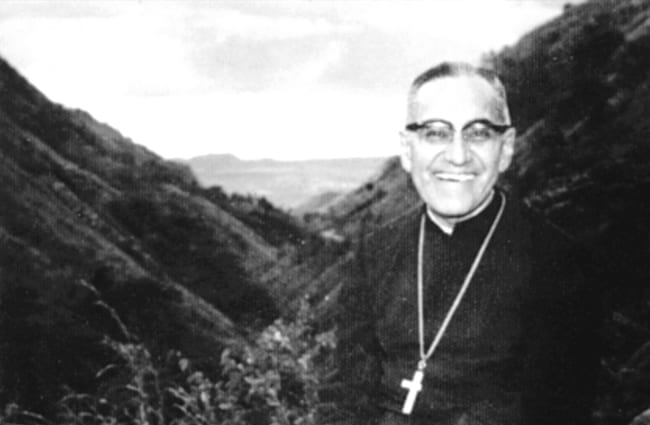
(CNS photo/Equipo Maiz, courtesy CAFOD, Just One World)
It was Archbishop Romero’s determination “to overcome his limitations in order to follow God’s call that the students most identify and find encouragement for themselves in their own struggles and challenges,” she said.
Pope Paul VI
Pope Paul VI, who was born Giovanni Battista Montini in 1897, was pope from 1963 to 1978. He presided over the final sessions of the Second Vatican Council and its initial implementation.
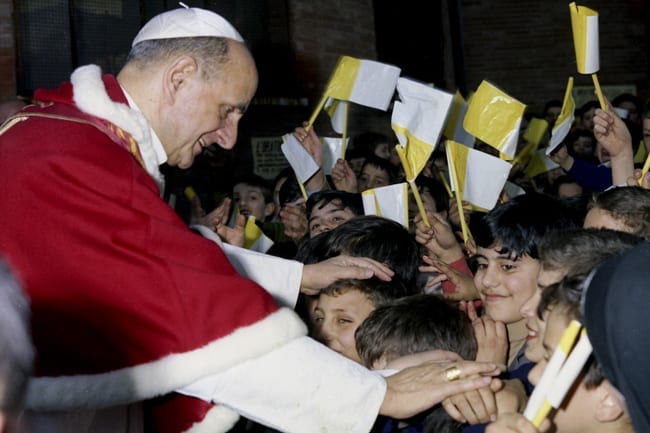
Pope Paul VI greets children as he visits the Church of St. Leo the Great in Rome March 31, 1968. (CNS photo/Giancarlo Giuliani, Catholic Press Photo)
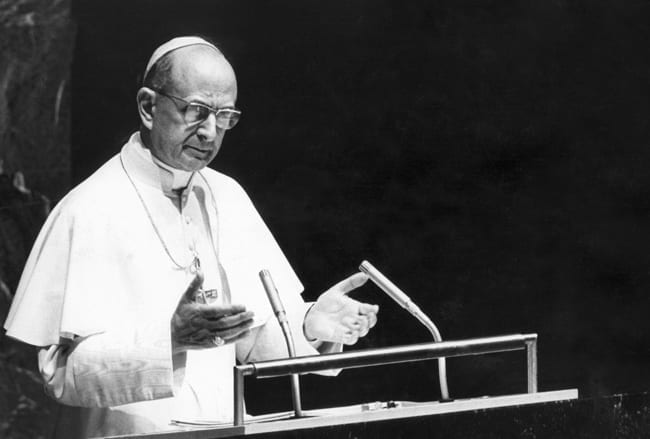
Pope Paul VI makes a special appeal for world peace in 1965 at United Nations headquarters in New York. (CNS photo/Yutaka Nagata, U.N.)
Pope Paul VI died at Castel Gandolfo on August 6, 1978, and was buried in St. Peter’s Basilica. He was beatified on Oct. 19, 2014.
A Friendship between Saints
Pope Paul VI is also remembered as a strong leader who was close to Catholics who suffered persecution, including Archbishop Romero.
The two men crossed paths on their road to sainthood and formed a personal friendship that strengthened each other’s resolve in the face of growing challenges, according to Roberto Morozzo della Rocca, a professor of contemporary history at Roma Tre University and author of a biography of Romero.
In 1977, Paul VI appointed Romero to lead the archdiocese of San Salvador during a tumultuous time when priests and religious who stood with the poor were targeted by right-wing paramilitary groups aligned with the government.
Manuel Roberto Lopez, El Salvador’s ambassador to the Holy See, said the canonization of Romero “seemed like an impossible dream for us Salvadorans,” and his being declared a saint alongside Pope Paul was the culmination of “a history of friendship.”
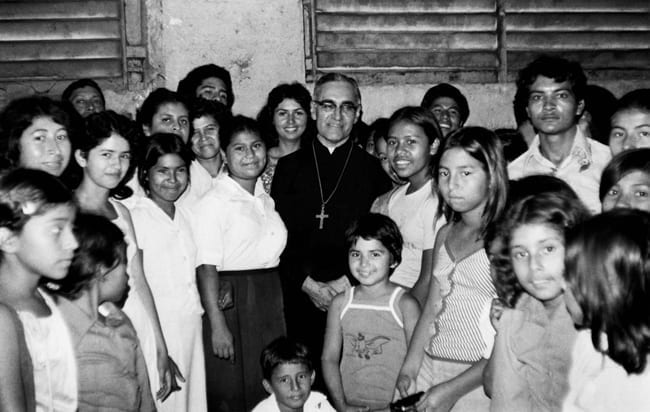
Archbishop Oscar Romero poses for a photo with women and children in this undated photo from El Salvador. (CNS/Octavio Duran)
Although the archbishop of San Salvador enjoyed the trust of Blessed Paul VI, many within the Roman Curia viewed him in a negative light after he became more vocal against the right-wing paramilitary government following the assassination in 1977 of his friend, Jesuit Father Rutilio Grande, who was known as a champion of the poor and the oppressed in El Salvador.
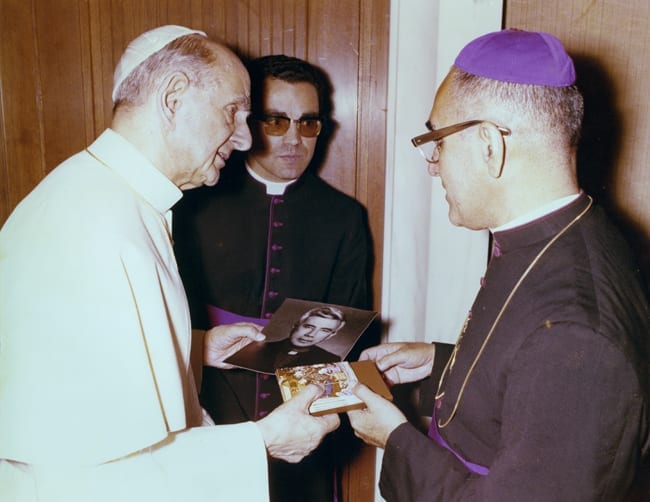
Archbishop Oscar Romero giving a portrait of Fr. Rutilio Grande, SJ, to Pope Paul VI. (Romero Foundation)
At Fr. Grande’s funeral, Archbishop Romero said, “The liberation Fr. Grande preached was inspired by faith.”
After Fr. Grande’s death, Archbishop Romero became more outspoken, which often drew warnings from the apostolic nuncio to exercise prudence. This prompted Archbishop Romero to travel to Rome and meet with the pope on March 26, 1977.
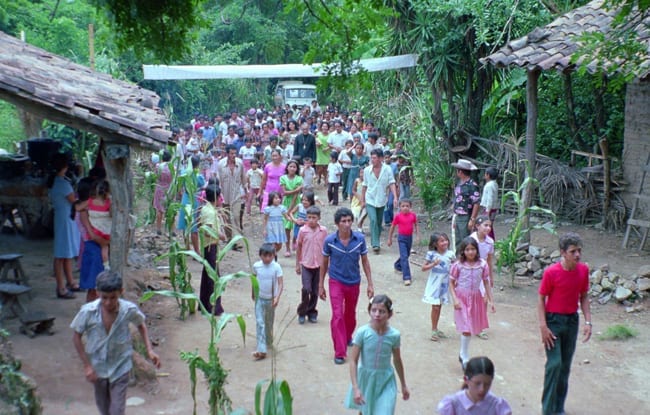
A crowd of people from San Antonio Los Ranchos in Chalatenango, El Salvador, walk with Archbishop Oscar Romero as he arrives to celebrate Mass in 1979. The archbishop was detained and interrogated by soldiers for 20 minutes before being allowed to continue his pastoral visit. Fearing violence, he asked that the Mass be celebrated outdoors. (CNS/Octavio Duran)
Pope Paul “told him fraternally a phrase that was the encouragement that Romero needed: ‘Animo! Tu eres el que manda!’ (‘Courage! You’re the one in charge!’),” Morozzo said.
Romero’s diary, Morozzo added, offered a glimpse into the mutual respect and affection between the two future saints during their next meeting in June 1978.
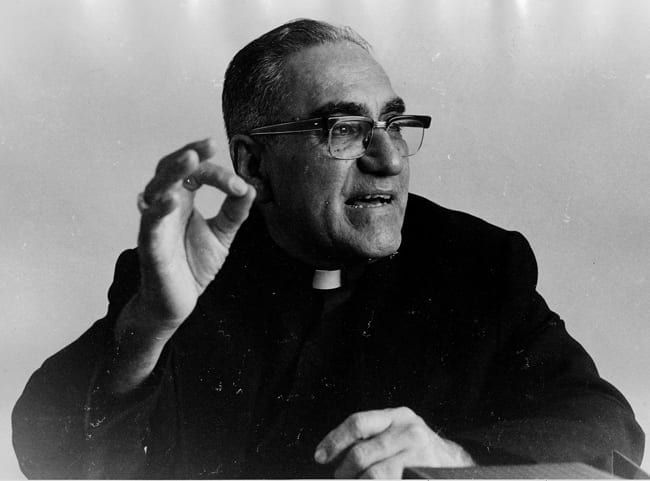
Archbishop Oscar Romero in the late 1970s. (NCR photo/June Carolyn Erlick)
According to Archbishop Romero, Pope Paul said, “I understand your difficult work. It is a work that perhaps may not be understood; you need to have a lot of patience and strength. I know that not everyone thinks like you; it is difficult in the circumstances of your country to find that unanimity of thought. Nevertheless, proceed with courage, with patience, with strength and with hope.” [Sources: CNS, Crux, OSV, CNS, CNS, CNS]

